Analyzing Community Management and Organization: A Case Study Approach
VerifiedAdded on 2022/11/28
|8
|1447
|226
Case Study
AI Summary
This case study delves into community management and organizational culture, focusing on the Woodson Foundation, a non-profit social service agency. It explores team dynamics, integrative bargaining, and organizational culture to enhance learning outcomes. The analysis covers the development team's responsibilities, dominant perspectives on team formation, and suggestions for effective group members. It also provides advice on managing conflicts, leveraging integrative negotiation strategies, and fostering a transformational message for employees and parents. The study emphasizes the importance of a workforce coalition, team coordination, and mutual respect to create a positive work environment. The case study also examines the cultures of stakeholder organizations and strategies for managing diversity issues to maintain workforce productivity and prevent interpersonal conflicts. The conclusion highlights the benefits of workforce coalitions in promoting team performance and organizational culture.
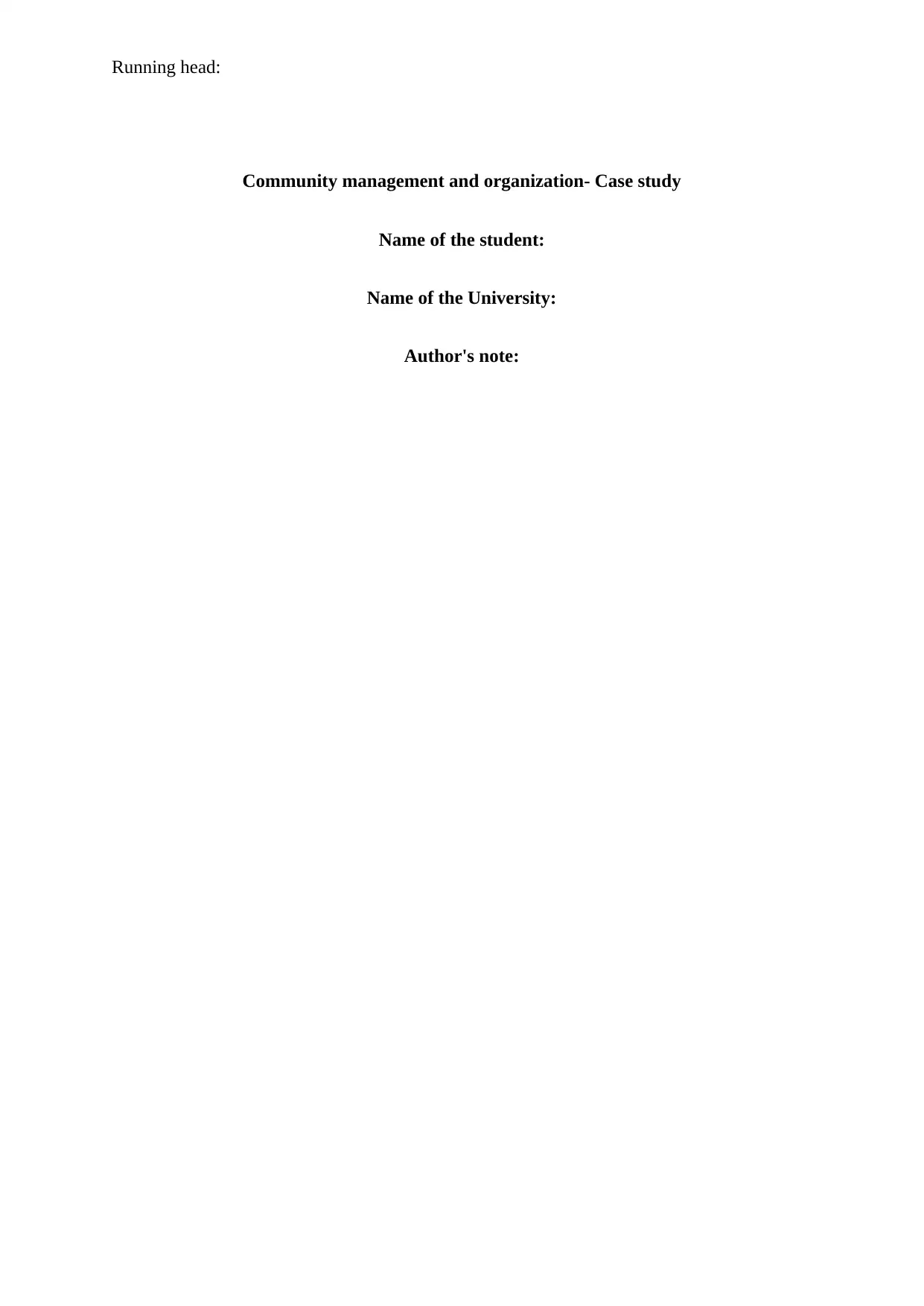
Running head:
Community management and organization- Case study
Name of the student:
Name of the University:
Author's note:
Community management and organization- Case study
Name of the student:
Name of the University:
Author's note:
Paraphrase This Document
Need a fresh take? Get an instant paraphrase of this document with our AI Paraphraser
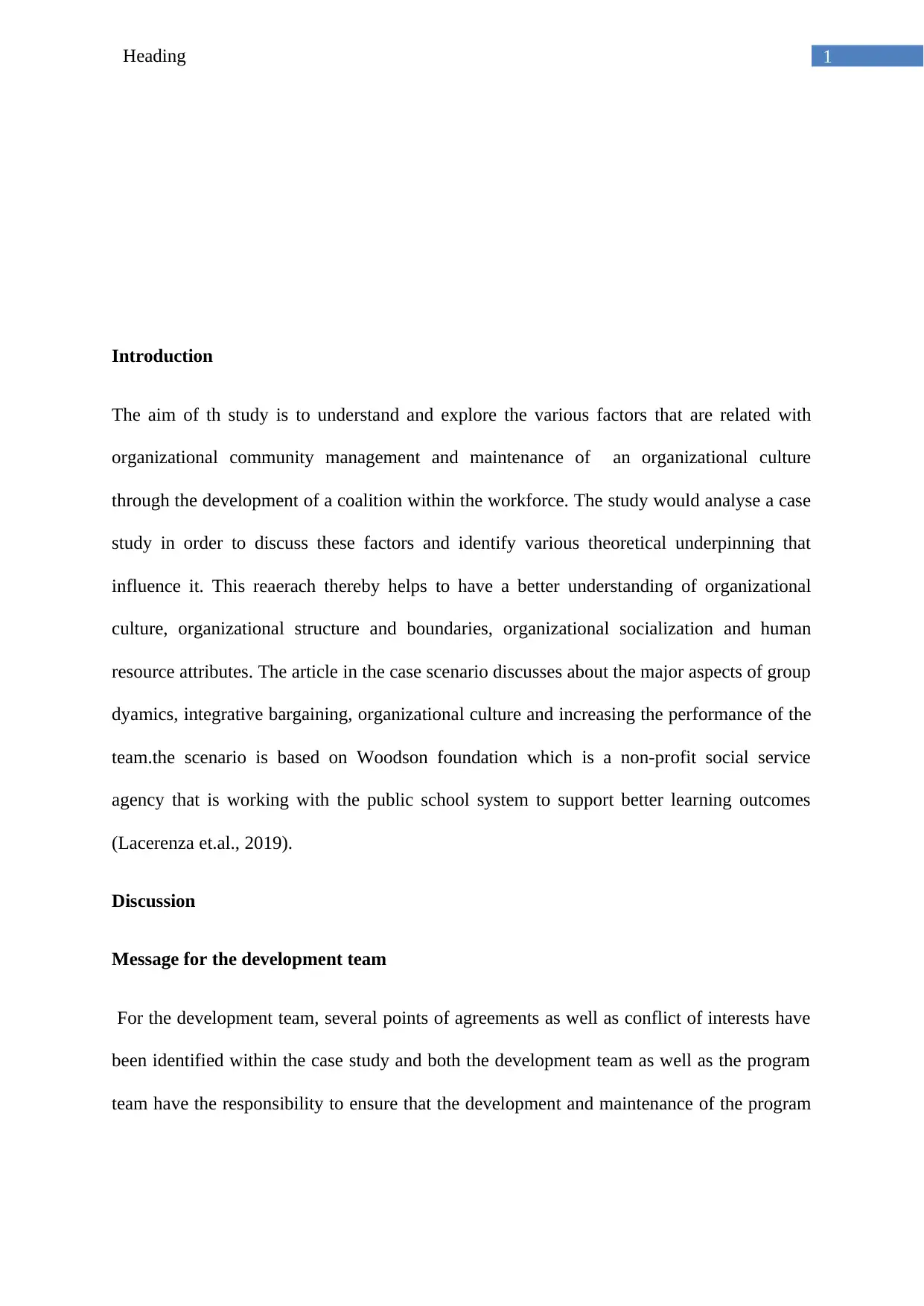
1Heading
Introduction
The aim of th study is to understand and explore the various factors that are related with
organizational community management and maintenance of an organizational culture
through the development of a coalition within the workforce. The study would analyse a case
study in order to discuss these factors and identify various theoretical underpinning that
influence it. This reaerach thereby helps to have a better understanding of organizational
culture, organizational structure and boundaries, organizational socialization and human
resource attributes. The article in the case scenario discusses about the major aspects of group
dyamics, integrative bargaining, organizational culture and increasing the performance of the
team.the scenario is based on Woodson foundation which is a non-profit social service
agency that is working with the public school system to support better learning outcomes
(Lacerenza et.al., 2019).
Discussion
Message for the development team
For the development team, several points of agreements as well as conflict of interests have
been identified within the case study and both the development team as well as the program
team have the responsibility to ensure that the development and maintenance of the program
Introduction
The aim of th study is to understand and explore the various factors that are related with
organizational community management and maintenance of an organizational culture
through the development of a coalition within the workforce. The study would analyse a case
study in order to discuss these factors and identify various theoretical underpinning that
influence it. This reaerach thereby helps to have a better understanding of organizational
culture, organizational structure and boundaries, organizational socialization and human
resource attributes. The article in the case scenario discusses about the major aspects of group
dyamics, integrative bargaining, organizational culture and increasing the performance of the
team.the scenario is based on Woodson foundation which is a non-profit social service
agency that is working with the public school system to support better learning outcomes
(Lacerenza et.al., 2019).
Discussion
Message for the development team
For the development team, several points of agreements as well as conflict of interests have
been identified within the case study and both the development team as well as the program
team have the responsibility to ensure that the development and maintenance of the program
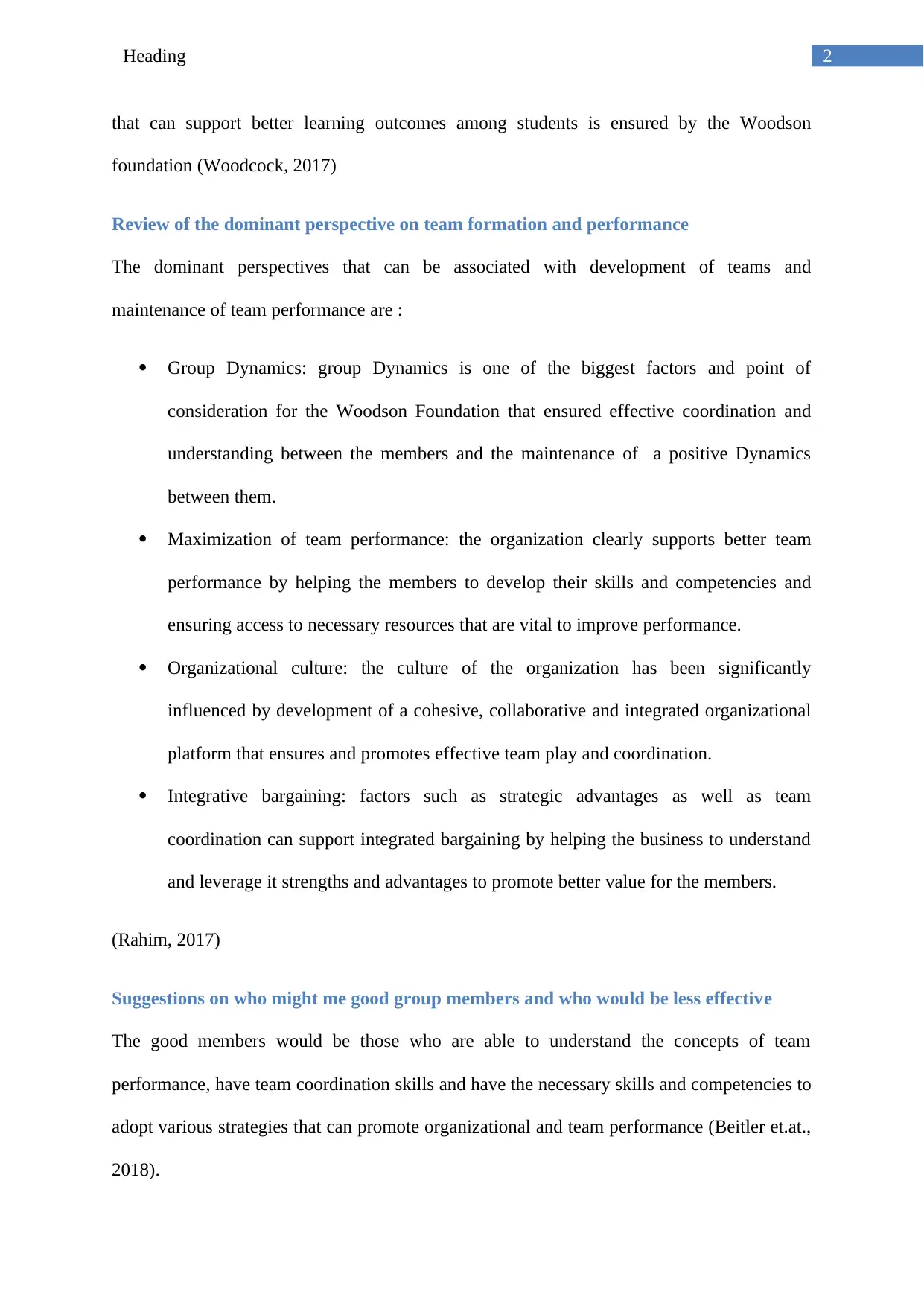
2Heading
that can support better learning outcomes among students is ensured by the Woodson
foundation (Woodcock, 2017)
Review of the dominant perspective on team formation and performance
The dominant perspectives that can be associated with development of teams and
maintenance of team performance are :
Group Dynamics: group Dynamics is one of the biggest factors and point of
consideration for the Woodson Foundation that ensured effective coordination and
understanding between the members and the maintenance of a positive Dynamics
between them.
Maximization of team performance: the organization clearly supports better team
performance by helping the members to develop their skills and competencies and
ensuring access to necessary resources that are vital to improve performance.
Organizational culture: the culture of the organization has been significantly
influenced by development of a cohesive, collaborative and integrated organizational
platform that ensures and promotes effective team play and coordination.
Integrative bargaining: factors such as strategic advantages as well as team
coordination can support integrated bargaining by helping the business to understand
and leverage it strengths and advantages to promote better value for the members.
(Rahim, 2017)
Suggestions on who might me good group members and who would be less effective
The good members would be those who are able to understand the concepts of team
performance, have team coordination skills and have the necessary skills and competencies to
adopt various strategies that can promote organizational and team performance (Beitler et.at.,
2018).
that can support better learning outcomes among students is ensured by the Woodson
foundation (Woodcock, 2017)
Review of the dominant perspective on team formation and performance
The dominant perspectives that can be associated with development of teams and
maintenance of team performance are :
Group Dynamics: group Dynamics is one of the biggest factors and point of
consideration for the Woodson Foundation that ensured effective coordination and
understanding between the members and the maintenance of a positive Dynamics
between them.
Maximization of team performance: the organization clearly supports better team
performance by helping the members to develop their skills and competencies and
ensuring access to necessary resources that are vital to improve performance.
Organizational culture: the culture of the organization has been significantly
influenced by development of a cohesive, collaborative and integrated organizational
platform that ensures and promotes effective team play and coordination.
Integrative bargaining: factors such as strategic advantages as well as team
coordination can support integrated bargaining by helping the business to understand
and leverage it strengths and advantages to promote better value for the members.
(Rahim, 2017)
Suggestions on who might me good group members and who would be less effective
The good members would be those who are able to understand the concepts of team
performance, have team coordination skills and have the necessary skills and competencies to
adopt various strategies that can promote organizational and team performance (Beitler et.at.,
2018).
⊘ This is a preview!⊘
Do you want full access?
Subscribe today to unlock all pages.

Trusted by 1+ million students worldwide
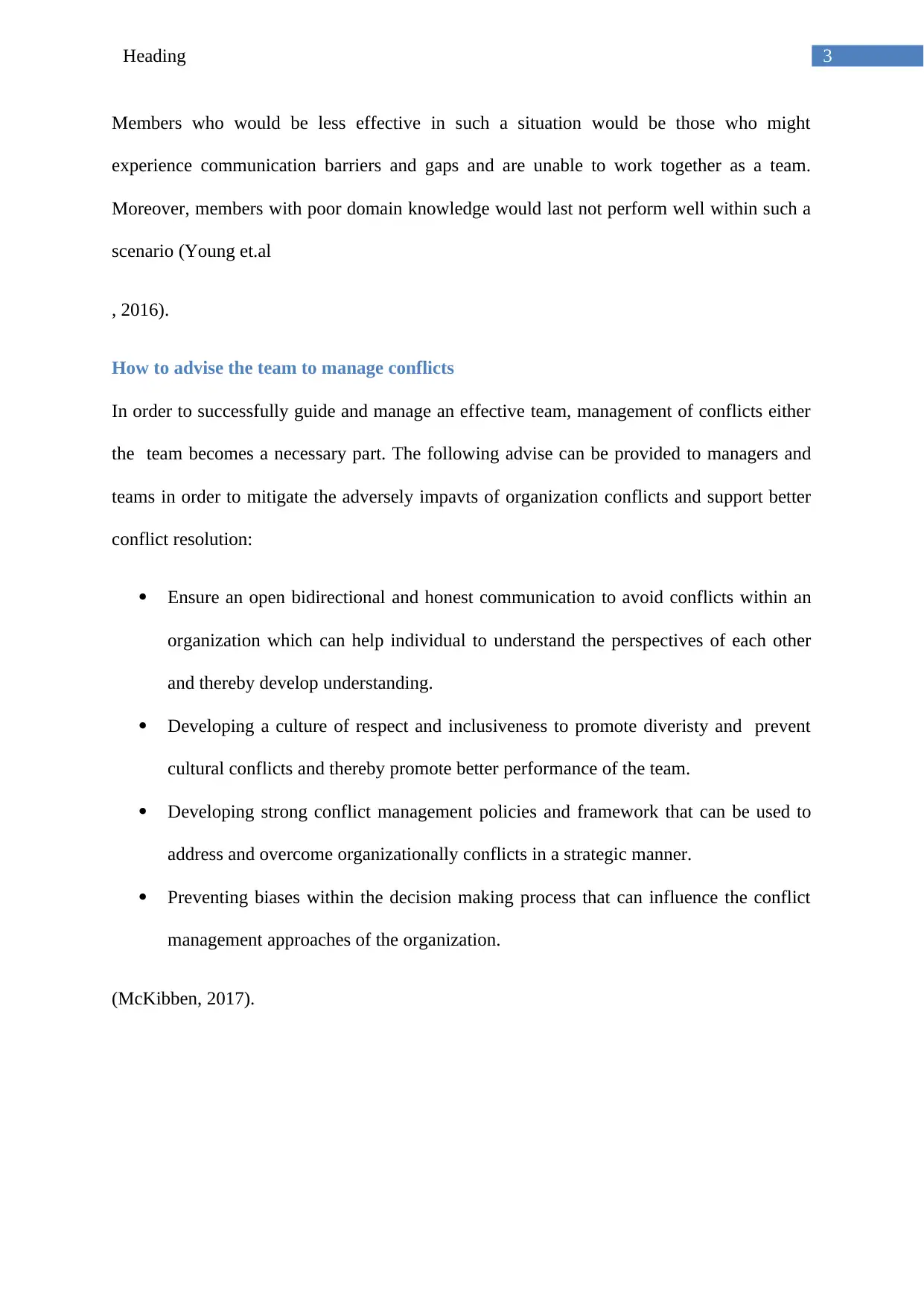
3Heading
Members who would be less effective in such a situation would be those who might
experience communication barriers and gaps and are unable to work together as a team.
Moreover, members with poor domain knowledge would last not perform well within such a
scenario (Young et.al
, 2016).
How to advise the team to manage conflicts
In order to successfully guide and manage an effective team, management of conflicts either
the team becomes a necessary part. The following advise can be provided to managers and
teams in order to mitigate the adversely impavts of organization conflicts and support better
conflict resolution:
Ensure an open bidirectional and honest communication to avoid conflicts within an
organization which can help individual to understand the perspectives of each other
and thereby develop understanding.
Developing a culture of respect and inclusiveness to promote diveristy and prevent
cultural conflicts and thereby promote better performance of the team.
Developing strong conflict management policies and framework that can be used to
address and overcome organizationally conflicts in a strategic manner.
Preventing biases within the decision making process that can influence the conflict
management approaches of the organization.
(McKibben, 2017).
Members who would be less effective in such a situation would be those who might
experience communication barriers and gaps and are unable to work together as a team.
Moreover, members with poor domain knowledge would last not perform well within such a
scenario (Young et.al
, 2016).
How to advise the team to manage conflicts
In order to successfully guide and manage an effective team, management of conflicts either
the team becomes a necessary part. The following advise can be provided to managers and
teams in order to mitigate the adversely impavts of organization conflicts and support better
conflict resolution:
Ensure an open bidirectional and honest communication to avoid conflicts within an
organization which can help individual to understand the perspectives of each other
and thereby develop understanding.
Developing a culture of respect and inclusiveness to promote diveristy and prevent
cultural conflicts and thereby promote better performance of the team.
Developing strong conflict management policies and framework that can be used to
address and overcome organizationally conflicts in a strategic manner.
Preventing biases within the decision making process that can influence the conflict
management approaches of the organization.
(McKibben, 2017).
Paraphrase This Document
Need a fresh take? Get an instant paraphrase of this document with our AI Paraphraser
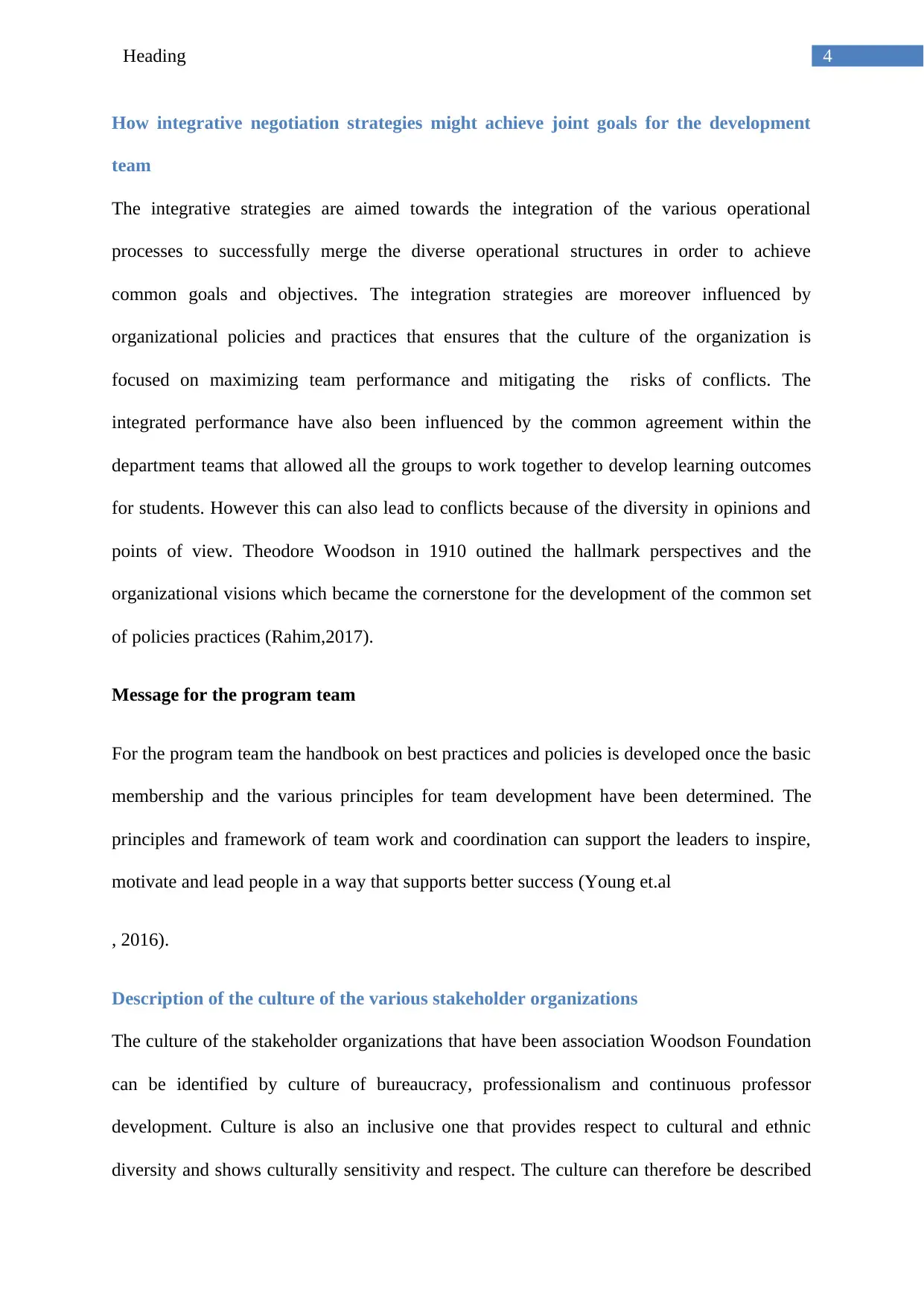
4Heading
How integrative negotiation strategies might achieve joint goals for the development
team
The integrative strategies are aimed towards the integration of the various operational
processes to successfully merge the diverse operational structures in order to achieve
common goals and objectives. The integration strategies are moreover influenced by
organizational policies and practices that ensures that the culture of the organization is
focused on maximizing team performance and mitigating the risks of conflicts. The
integrated performance have also been influenced by the common agreement within the
department teams that allowed all the groups to work together to develop learning outcomes
for students. However this can also lead to conflicts because of the diversity in opinions and
points of view. Theodore Woodson in 1910 outined the hallmark perspectives and the
organizational visions which became the cornerstone for the development of the common set
of policies practices (Rahim,2017).
Message for the program team
For the program team the handbook on best practices and policies is developed once the basic
membership and the various principles for team development have been determined. The
principles and framework of team work and coordination can support the leaders to inspire,
motivate and lead people in a way that supports better success (Young et.al
, 2016).
Description of the culture of the various stakeholder organizations
The culture of the stakeholder organizations that have been association Woodson Foundation
can be identified by culture of bureaucracy, professionalism and continuous professor
development. Culture is also an inclusive one that provides respect to cultural and ethnic
diversity and shows culturally sensitivity and respect. The culture can therefore be described
How integrative negotiation strategies might achieve joint goals for the development
team
The integrative strategies are aimed towards the integration of the various operational
processes to successfully merge the diverse operational structures in order to achieve
common goals and objectives. The integration strategies are moreover influenced by
organizational policies and practices that ensures that the culture of the organization is
focused on maximizing team performance and mitigating the risks of conflicts. The
integrated performance have also been influenced by the common agreement within the
department teams that allowed all the groups to work together to develop learning outcomes
for students. However this can also lead to conflicts because of the diversity in opinions and
points of view. Theodore Woodson in 1910 outined the hallmark perspectives and the
organizational visions which became the cornerstone for the development of the common set
of policies practices (Rahim,2017).
Message for the program team
For the program team the handbook on best practices and policies is developed once the basic
membership and the various principles for team development have been determined. The
principles and framework of team work and coordination can support the leaders to inspire,
motivate and lead people in a way that supports better success (Young et.al
, 2016).
Description of the culture of the various stakeholder organizations
The culture of the stakeholder organizations that have been association Woodson Foundation
can be identified by culture of bureaucracy, professionalism and continuous professor
development. Culture is also an inclusive one that provides respect to cultural and ethnic
diversity and shows culturally sensitivity and respect. The culture can therefore be described
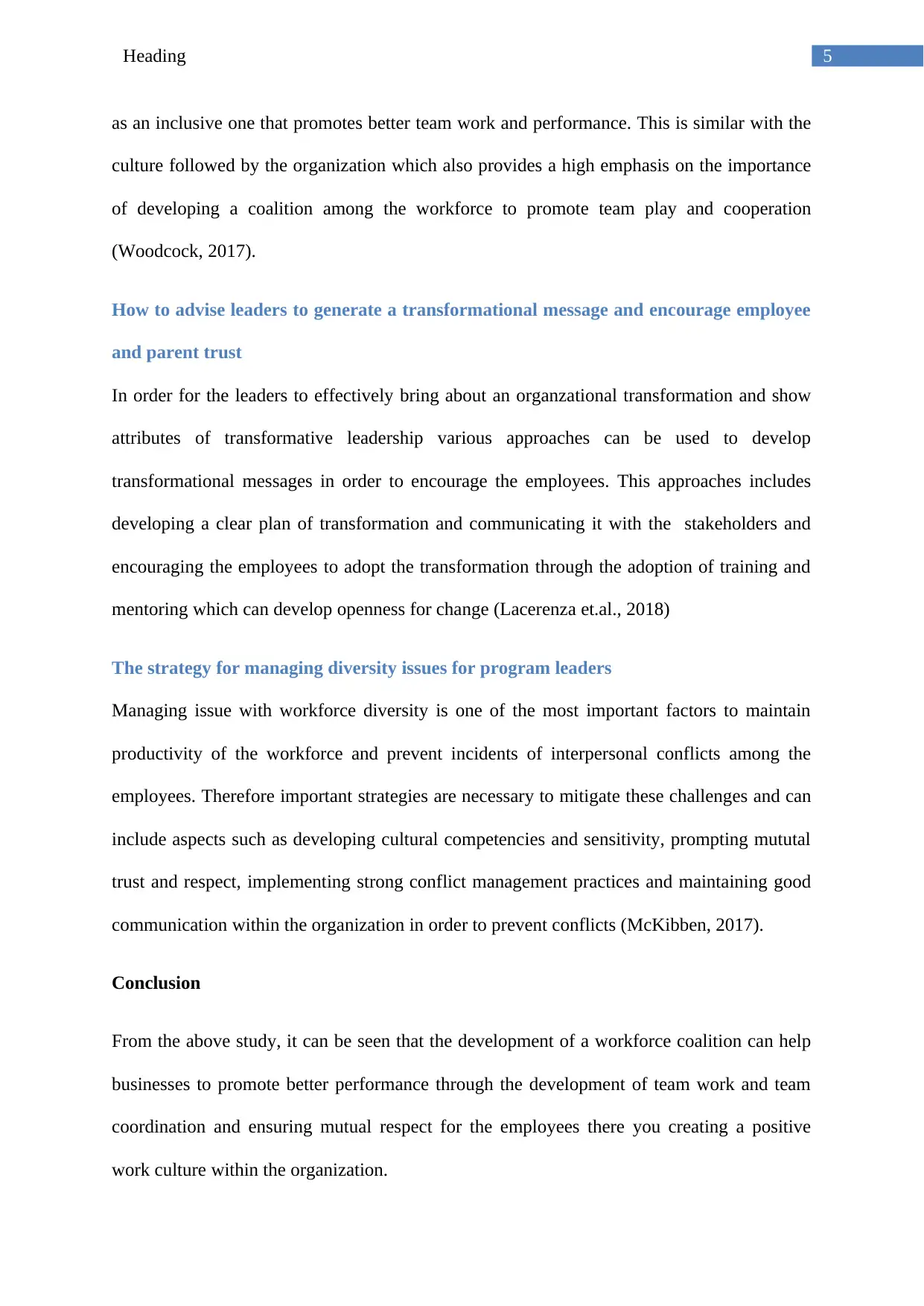
5Heading
as an inclusive one that promotes better team work and performance. This is similar with the
culture followed by the organization which also provides a high emphasis on the importance
of developing a coalition among the workforce to promote team play and cooperation
(Woodcock, 2017).
How to advise leaders to generate a transformational message and encourage employee
and parent trust
In order for the leaders to effectively bring about an organzational transformation and show
attributes of transformative leadership various approaches can be used to develop
transformational messages in order to encourage the employees. This approaches includes
developing a clear plan of transformation and communicating it with the stakeholders and
encouraging the employees to adopt the transformation through the adoption of training and
mentoring which can develop openness for change (Lacerenza et.al., 2018)
The strategy for managing diversity issues for program leaders
Managing issue with workforce diversity is one of the most important factors to maintain
productivity of the workforce and prevent incidents of interpersonal conflicts among the
employees. Therefore important strategies are necessary to mitigate these challenges and can
include aspects such as developing cultural competencies and sensitivity, prompting mututal
trust and respect, implementing strong conflict management practices and maintaining good
communication within the organization in order to prevent conflicts (McKibben, 2017).
Conclusion
From the above study, it can be seen that the development of a workforce coalition can help
businesses to promote better performance through the development of team work and team
coordination and ensuring mutual respect for the employees there you creating a positive
work culture within the organization.
as an inclusive one that promotes better team work and performance. This is similar with the
culture followed by the organization which also provides a high emphasis on the importance
of developing a coalition among the workforce to promote team play and cooperation
(Woodcock, 2017).
How to advise leaders to generate a transformational message and encourage employee
and parent trust
In order for the leaders to effectively bring about an organzational transformation and show
attributes of transformative leadership various approaches can be used to develop
transformational messages in order to encourage the employees. This approaches includes
developing a clear plan of transformation and communicating it with the stakeholders and
encouraging the employees to adopt the transformation through the adoption of training and
mentoring which can develop openness for change (Lacerenza et.al., 2018)
The strategy for managing diversity issues for program leaders
Managing issue with workforce diversity is one of the most important factors to maintain
productivity of the workforce and prevent incidents of interpersonal conflicts among the
employees. Therefore important strategies are necessary to mitigate these challenges and can
include aspects such as developing cultural competencies and sensitivity, prompting mututal
trust and respect, implementing strong conflict management practices and maintaining good
communication within the organization in order to prevent conflicts (McKibben, 2017).
Conclusion
From the above study, it can be seen that the development of a workforce coalition can help
businesses to promote better performance through the development of team work and team
coordination and ensuring mutual respect for the employees there you creating a positive
work culture within the organization.
⊘ This is a preview!⊘
Do you want full access?
Subscribe today to unlock all pages.

Trusted by 1+ million students worldwide
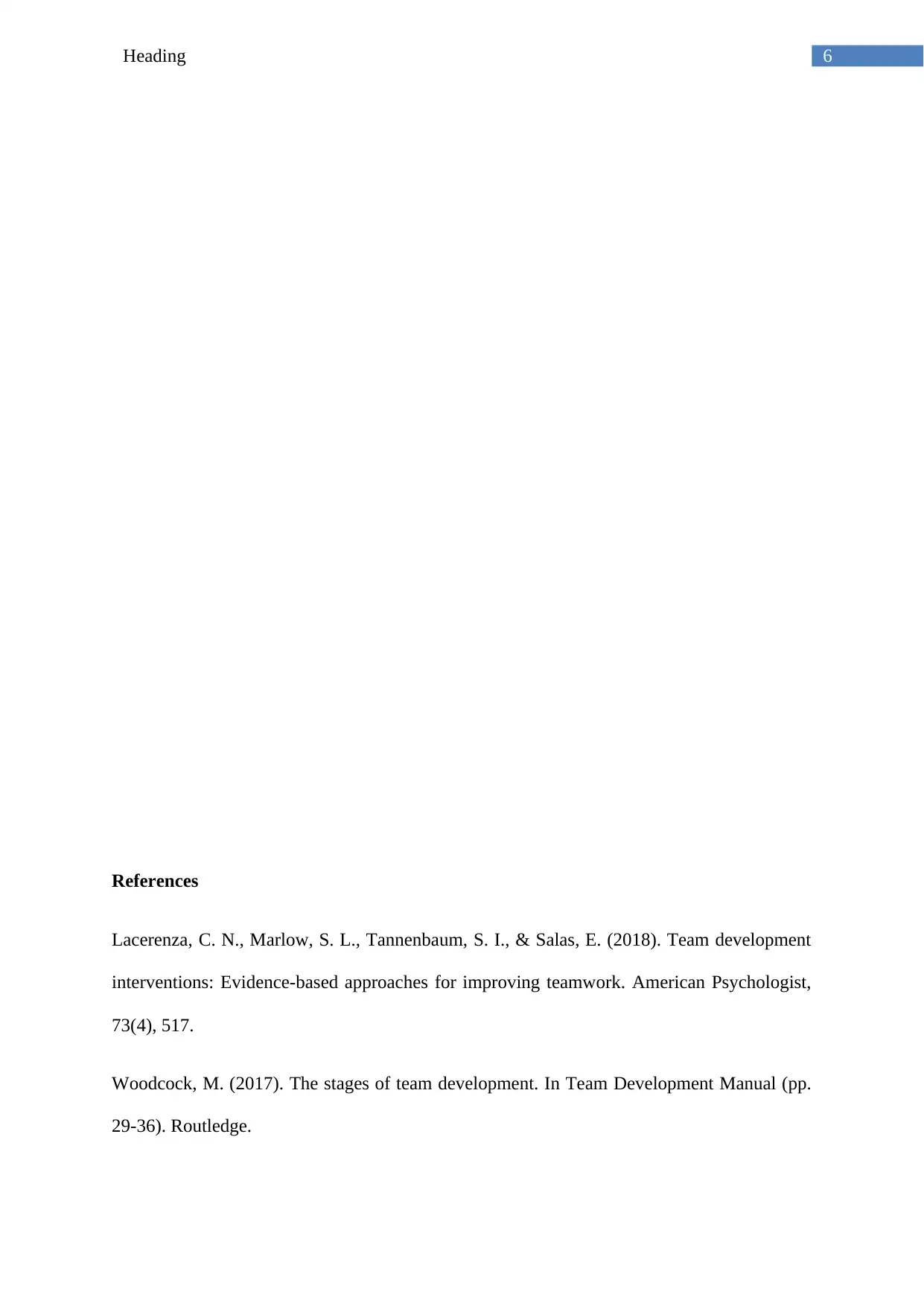
6Heading
References
Lacerenza, C. N., Marlow, S. L., Tannenbaum, S. I., & Salas, E. (2018). Team development
interventions: Evidence-based approaches for improving teamwork. American Psychologist,
73(4), 517.
Woodcock, M. (2017). The stages of team development. In Team Development Manual (pp.
29-36). Routledge.
References
Lacerenza, C. N., Marlow, S. L., Tannenbaum, S. I., & Salas, E. (2018). Team development
interventions: Evidence-based approaches for improving teamwork. American Psychologist,
73(4), 517.
Woodcock, M. (2017). The stages of team development. In Team Development Manual (pp.
29-36). Routledge.
Paraphrase This Document
Need a fresh take? Get an instant paraphrase of this document with our AI Paraphraser
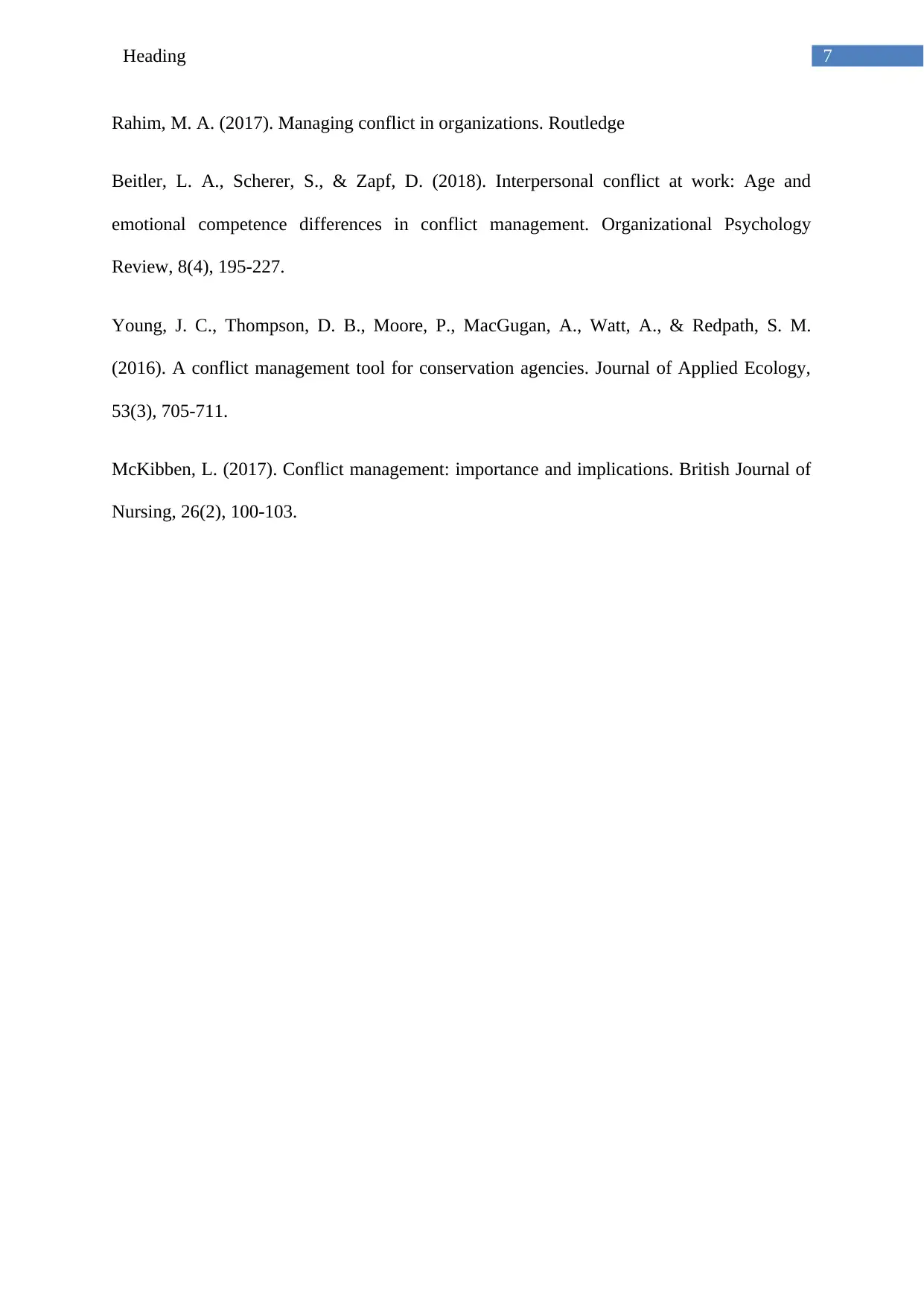
7Heading
Rahim, M. A. (2017). Managing conflict in organizations. Routledge
Beitler, L. A., Scherer, S., & Zapf, D. (2018). Interpersonal conflict at work: Age and
emotional competence differences in conflict management. Organizational Psychology
Review, 8(4), 195-227.
Young, J. C., Thompson, D. B., Moore, P., MacGugan, A., Watt, A., & Redpath, S. M.
(2016). A conflict management tool for conservation agencies. Journal of Applied Ecology,
53(3), 705-711.
McKibben, L. (2017). Conflict management: importance and implications. British Journal of
Nursing, 26(2), 100-103.
Rahim, M. A. (2017). Managing conflict in organizations. Routledge
Beitler, L. A., Scherer, S., & Zapf, D. (2018). Interpersonal conflict at work: Age and
emotional competence differences in conflict management. Organizational Psychology
Review, 8(4), 195-227.
Young, J. C., Thompson, D. B., Moore, P., MacGugan, A., Watt, A., & Redpath, S. M.
(2016). A conflict management tool for conservation agencies. Journal of Applied Ecology,
53(3), 705-711.
McKibben, L. (2017). Conflict management: importance and implications. British Journal of
Nursing, 26(2), 100-103.
1 out of 8
Related Documents
Your All-in-One AI-Powered Toolkit for Academic Success.
+13062052269
info@desklib.com
Available 24*7 on WhatsApp / Email
![[object Object]](/_next/static/media/star-bottom.7253800d.svg)
Unlock your academic potential
Copyright © 2020–2025 A2Z Services. All Rights Reserved. Developed and managed by ZUCOL.





